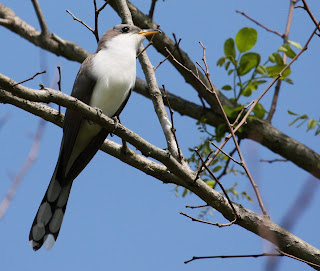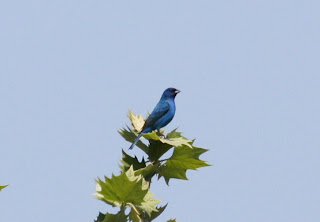I'm at 199 species for the year. It's very exciting to speculate... to wonder what bird might be # 200. ROSE BREASTED GROSBEAK, GREAT CRESTED FLYCATCHER, WHITE-WINGED TERN, or perhaps some variety of WARBLER?
Meantime, enjoy these latest to pose for my camera: YELLOW-BILLED CUCKOO, INDIGO BUNTING & a PRAIRIE WARBLER.
 Yes, the YELLOW-BILLED CUCKOO has occasionally been known to lay it's eggs in other bird's nests. That gesture isn't very nice, to be sure. But on the bright side, CUCKOOS eat lots of caterpillars. I don't know if you've noticed yet, but this year looks like it's going to be a very bad one for bag worm caterpillars. So... eat up CUCKOO! And if you must, I hope that you lay your CUCKOO eggs in either a EUROPEAN STARLING or a HOUSE SPARROW nest.
Yes, the YELLOW-BILLED CUCKOO has occasionally been known to lay it's eggs in other bird's nests. That gesture isn't very nice, to be sure. But on the bright side, CUCKOOS eat lots of caterpillars. I don't know if you've noticed yet, but this year looks like it's going to be a very bad one for bag worm caterpillars. So... eat up CUCKOO! And if you must, I hope that you lay your CUCKOO eggs in either a EUROPEAN STARLING or a HOUSE SPARROW nest.

 The INDIGO BUNTING is known to have regional dialects. Basically, when this bird sings, it has a bit of an accent. There is a good chance that the one shown here prolly has a Balmer accent hon.
The INDIGO BUNTING is known to have regional dialects. Basically, when this bird sings, it has a bit of an accent. There is a good chance that the one shown here prolly has a Balmer accent hon. The PRAIRIE WARBLER has a whispy song that increases in speed and pitch. Sadly, this bird is declining in numbers throughout North America. PRAIRIE WARBLERS like shrubby habitat. America is either becoming strip malls, housing developments, farm land or forests. Far too infrequently, grassy fields and shrubby habitat is not thought of as valuable or important.
The PRAIRIE WARBLER has a whispy song that increases in speed and pitch. Sadly, this bird is declining in numbers throughout North America. PRAIRIE WARBLERS like shrubby habitat. America is either becoming strip malls, housing developments, farm land or forests. Far too infrequently, grassy fields and shrubby habitat is not thought of as valuable or important.
 Take Care and plant some shrubs.
Take Care and plant some shrubs.
Dan









No comments:
Post a Comment